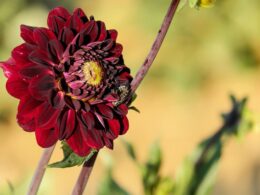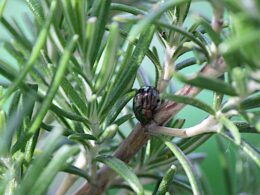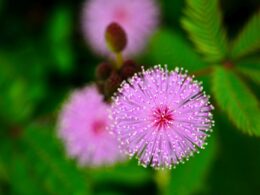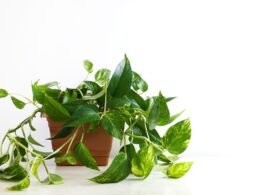What Is a Croton Plant? Names, Origin, and Characteristics
Before we tell you all about croton plant care, let’s introduce the plant. The croton (Codiaeum variegatum) is an evergreen shrub native to Australia, Indonesia and Malaysia. It’s commonly known by a few different names, such as:
- variegated laurel;
- fire croton;
- garden croton.
The leaves of the croton plant are what makes it distinctively beautiful, with colors ranging from yellow and green to red and purple. Outdoors, the croton plant can reach heights of up to 10 feet. When grown indoors, however, it’s typically much smaller. These tropical plants are typically easy to care for and make for lovely houseplants.
Croton Plant Care – Soil and Fertilization
Crotons do best in rich, loamy potting soil that is well-draining. If your croton is potted, be sure to use a pot with drainage holes to prevent the roots from sitting in water. It’s also important to fertilize your croton regularly. Use a balanced fertilizer every two weeks during the growing season (spring and summer). You can reduce the frequency to once a month during the fall and winter.
Croton Plant Care – Watering Requirements
Croton plant care isn’t too hard, but you do need to be careful not to overwater your indoor plant. The soil should be moist, but never soggy. Allow the top inch of soil to dry out between waterings. That way, you can be sure your croton is getting just the right amount of water.
If your croton is potted, be sure to check the drainage holes from time to time to make sure they’re not blocked. If they are, the roots will start to rot, and the plant might start dropping leaves.
Croton Care – Light Requirements
Croton plants need bright, indirect sunlight to thrive. If you can provide them with a few hours of direct sunlight each day, that’s even better if you live in a cooler climate. However, too much direct sunlight can scorch the foliage.
Croton Care – Temperature and Humidity Requirements
Proper croton plant care also means providing your plants with the right type of air. Crotons prefer warm, humid conditions. They’ll do fine in average household temperatures (between 60 and 85 degrees Fahrenheit), but they won’t tolerate drafts or cold snaps.
If you live in a dry climate, you might need to mist your croton plant from time to time to raise the humidity levels around it. You can also use a humidifier to keep the air around your croton plant nice and moist.
Growing crotons outdoors is possible in USDA hardiness zones nine and above. If you live in a cooler climate, you can still enjoy these beautiful plants by growing them indoors. Just be sure to provide them with the proper care, and they’ll thrive.
How Often Do You Need to Prune Crotons?
Crotons don’t require a lot of pruning, but you can trim them back if they start to get too leggy or if you want to encourage new growth. To do this, simply cut the stems back to the desired length. You can also pinch the tips of the stems to encourage new growth.
How Do You Propagate Crotons?
Croton plants are easy to propagate from stem cuttings. To do this, take a cutting from a healthy croton plant that is about four inches long. Cut just below a leaf node (the point where the leaf meets the stem). Remove the lower leaves from the cutting, and dip the end in rooting hormone.
Next, plant the cutting in a pot filled with moistened potting mix. Place the pot in a warm, humid location out of direct sunlight, and keep the soil moist. The cutting should root within four to six weeks. Once it has rooted, you can move it to a location with more light.
How Often Should You Repot Crotons?
Crotons don’t need to be repotted very often. You can generally get away with repotting them every two to three years. Use a pot that is only one size larger than the current pot. Crotons don’t like their roots to be disturbed, so it’s best not to go up more than one pot size.
When it’s time to repot your croton, simply remove it from its current pot and replant it in a new one filled with fresh potting mix. Be sure to water the plant well after repotting.
Common Problems with Croton Plants
Crotons grown indoors are generally quite hearty, but they can sometimes experience problems. Here are a few of the most common croton plant problems.
- Leaf drop. This can be caused by several factors, including dryness, pests, overwatering or disease.
- Browning or yellowing leaves. This is usually caused by too much direct sunlight or drafts.
- Pale leaves. If the leaves of your croton plant are pale, it might be getting too much direct sunlight.
- Pests. Spider mites, mealybugs, and scale can all infest crotons. These pests can cause the leaves to yellow or drop off.
- Bacterial and fungal diseases, such as root rot, leaf spot, and stem rot. If you notice any of these problems, remove the affected leaves or stems and dispose of them.
You can prevent many of these problems by sticking to the recommended croton plant care routine. With a bit of attention, crotons are relatively easy to grow and make a beautiful addition to any home.
Croton Plant Toxicity
Croton plants are toxic to humans and pets. The sap of the plant contains toxins that can cause skin irritation, stomach upset, and vomiting if ingested. If you have crotons in your home, be sure to keep them out of reach of children and pets.
Ready to Care for a Croton Plant?
To sum it up, croton plant care isn’t too difficult. These plants just need bright light, well-drained soil, and moderate watering to thrive. Be sure to keep an eye out for pests and diseases, and don’t forget to use fertilizer from time to time.



















